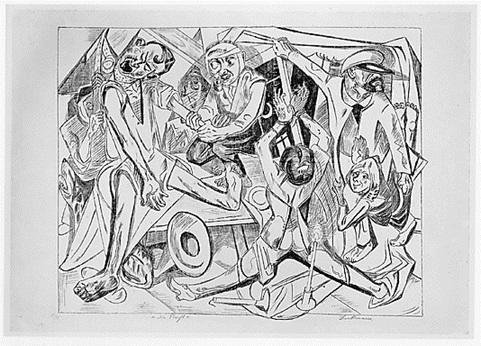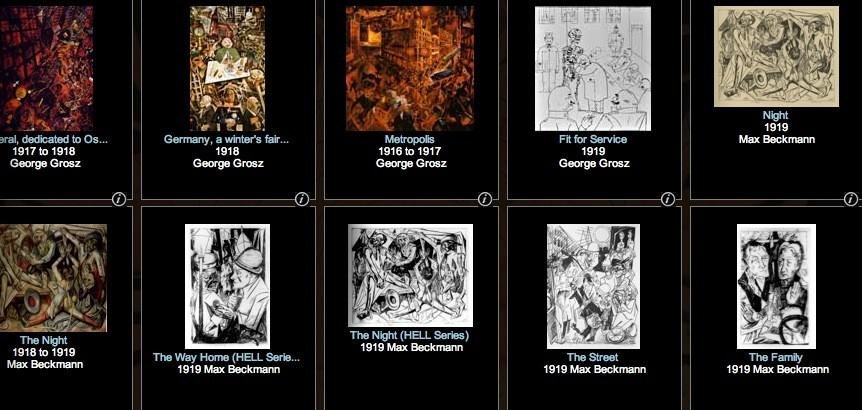War is one of the most hideous concepts that the humankind has ever come up with. While it is quite understandable that at the current stage of the development of humankind, some conflicts still have to be resolved with the use of coercive methods, war as a massive homicide still remains a truly revolting idea; and nowhere is this confrontation of common sense and humanism as evident as in the artworks of the artists of the WWI period, the time when the entire world seemed to be crashing into little pieces.
The artist whose name seems to be the most recognizable all over the world, Otto Dix and his works seem to be a perfect start for an analysis of the art of the WWI era.
The frightening images in the given picture capture the horror that seized the world as the WWI erupted. It is quite symbolic that the audience cannot see the faces of the people in the picture; however, it is not as much symbolic as the fact that the faces in the picture, with gas masks on them, remind much of skulls, with empty eye sockets looking like hollow tunnels leading to nowhere.

Definitely one of Dix’s strongest works, the given piece of art crosses with an artwork of another famous artist of the WWI era, Max Beckmann. Comparing the aforementioned picture by Dix with Beckmann’s Hell Series seems a touch far-fetched, seeing how the rest of Beckmann’s works are far from being as on-the-nose as any of Dix’s paintings.
However, the Hell Series was created as a response to the WWI events, which makes the given comparison rather legitimate. Unlike Dix, though, Beckmann does not seem to have his signature work, like Dix’s Stormtroops. On the contrary, every single piece of the Hell Series seems a piece of a single entity. Anyway, the Hell represents the author’s vision of the WWII and its insanity.

It is quite remarkable that in the given series, Beckmann avoided using his traditional color palette in several paintings, while in other ones belonging to the series, the color cast was quite aggressive, with a remarkable prevalence of orange and blue color.

The given feature of Beckmann’s works draws the line between his vision of the WWI and the one of Dix; the latter considering war a blood-hungry beats that turns people into machines designed solely for killing, Beckman clearly sees the pain and torture that the nations were going through, as well as the humanist dilemma between the need to protect oneself and one’s family and the ethical unacceptability of a murder, even the murder of an enemy.

The last, but definitely not the least among the artists who made a difference by showing the world the true face of war, George Grosz also had a very distinct way of expressing his attitude towards the WWI. What is remarkable is Grosz’s being a German; therefore, by viewing his works, the audience finally gets to see the response from the other side of barricade.
Weirdly enough, Grosz clearly focused on the bureaucratic implications behind the WWI process. For instance, the ink drawing Made in Germany, as well as Das neue Gesich der herrschenden Klasse, does not display either horror or magnificence; on the contrary, it shows the measly details of the post-war life in Germany, therefore, offering a grotesque vision of the WWI processes.

Despite the common theme, there are a number of differences between the artworks of the three painters, each of them reflecting his own experience and, therefore, personal vision of the war. To start with, the choice of the medium that the artists used to convey their ideas to the audience differs greatly.
While Beckmann definitely preferred oil on canvas, Grosz and Dix clearly trusted in the powerful effect of lines drawn with the help of ink. However, the differences between the three artists are not restricted to the formal elements of the paintings. It is clear that each of the artists incorporated his unique experience to create the paintings, which sets the artworks in question miles apart.
As it has been mentioned above, Grosz was the only one of the three who consciously mocked the meanness of the German bureaucracy of the time (Lazzari & Schleiser, 2011). The given mood in his art can be explained by harsh disappointment, which the artist had to go through after volunteering for the military service. The mockery of the German bureaucracy comes as a result of him being disillusioned. Beckmann’s motivations are a tad more complicated, yet nonetheless obvious.
Having to participate in the WWI, which resulted in him getting injured, he had a very personal hatred towards the WWI and the people who started it (Huppauf, 1997). The given specifics of Beckmann’s vision can be traced easily in his post-war paintings, especially in Hell of the birds, where an individual is being crippled and executed by the crowd. In his turn, Dix indulges into depicting the macabre of the WWI, the revelry of death, which he observed in the Battle of Somme (Tatar, 1997).
When comparing the artworks of the three artists, one might notice that of all three of them, Dix was the only one who was able to see the grotesque side of this macabre, while the other two displayed the horrors of the war with trepidation and dread.
Dix’s attitude towards the war seems to suck out all the emotion from the faces of the characters in his works; instead of portraying dismay and confusion, he left the faces covered, making it sure that the participants of the macabre in his artwork have little to no idea of what they are doing and why they are doing it. A complete loss of humanity and at the same time the hope for humanity is, thus, being depicted in a very graphic manner.
Even though the three artists use completely different techniques, each having his own recognizable style, their paintings share a common idea, i.e., the fact that war is a hideous crime against humanity. With that being said, it must be admitted that the ways in which the three artists envisioned the WWI share the intense feeling of despair and fear.
By far three most influential artists of the beginning of the XX century, Beckman, Dix and Grosz managed to embrace the horror that seized every single human being at the time and depict it in a way that makes the audience literally sense the atmosphere of the 1914–1918.
Reference List
Beckmann, M. (1919). Hell. Web.
Beckmann and Grosz: Selected works (n. d.).
Beckmann, M. (1938). Hell of the birds. Web.
Dix, O. (1924). Stormtroops advancing under gas. Web.
Huppauf, B.-R. (1997). War, Violence and the modern condition. New York, NY: DeGruyter.
Grosz, G. (1921). Das neue Gesich der herrschenden Klasse. Web.
Lazzari, M. R. & Schleiser, D. (2011). Exploring art: A global, thematic approach (4th ed.). Boston, MA: Wadsworth.
Tatar, M. (1997). Lustmord: Sexual murder in Weimar Germany. Princeton, NJ: Princeton University Press.